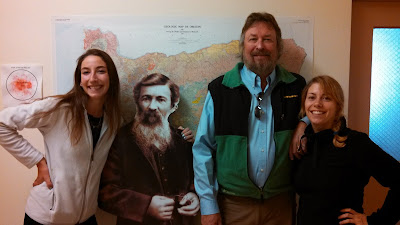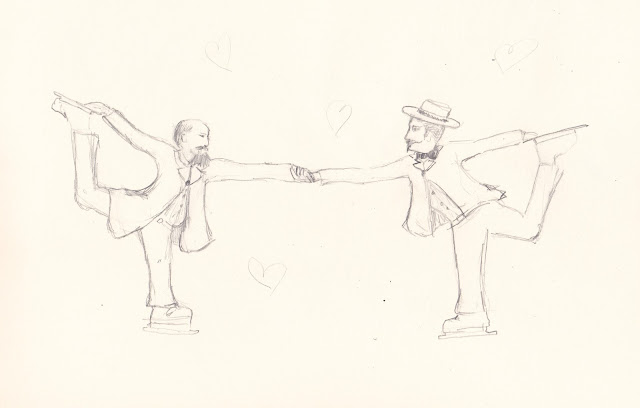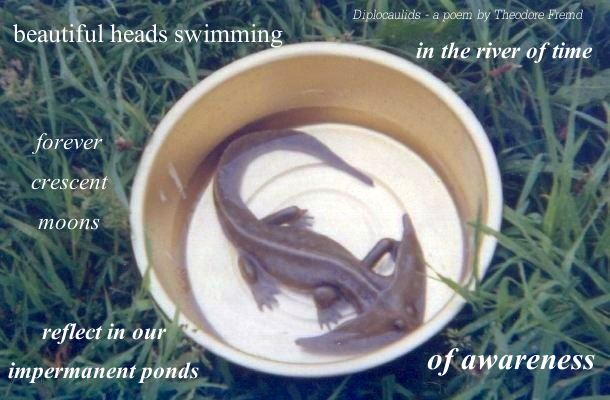| Prototaxites: Nature's threatening fungus-dildo |
Showing posts with label geological phalluses. Show all posts
Showing posts with label geological phalluses. Show all posts
Tuesday, December 17, 2013
Awesome Dead Shit: Prototaxites
When Amy has nightmares, they take one of two general forms: either all prosimians go extinct (OH GOD NO!) or it somehow involves giant mushrooms, of which she is irrationally opposed. So today to be an asshole, Meaghan is going to tell you all a lot about Prototaxites, the giant mushroom!
Sunday, August 25, 2013
Cope Loves Marsh 4Eva
Somewhere Cope and Marsh are rolling over in their graves right now... in order to gaze lovingly in the direction of the other. If you don't understand the context of this glorious drawing, please click here... it's not quite fanfic, but it definitely is the most productive Meaghan has ever been while suffering from a cold.
Saturday, June 29, 2013
Utah's Cock Rocks
Utah: a land rich with red rock outcrops, dinosaur fossils, Mormons, and extremely repressed sexuality. This state is so pure, in fact, that the Centers for Disease Control and Prevention have no data* about the sexual behaviors among high school students (grades 9-12):
*Absence of evidence IS NOT evidence of absence.
But if you're so lily pure, Utah, why is your geology so completely filthy? Wind and water have carved out sandstone schlongs across the state. Here we reveal a few of the more, ahem, prominent cases of dirty-minded rock formations via our favorite form of communication: limericks.
*Absence of evidence IS NOT evidence of absence.
But if you're so lily pure, Utah, why is your geology so completely filthy? Wind and water have carved out sandstone schlongs across the state. Here we reveal a few of the more, ahem, prominent cases of dirty-minded rock formations via our favorite form of communication: limericks.
Tuesday, April 9, 2013
The Real Ted Talks
We recently sat down with Ted Fremd, a Courtesy Research Associate at University of Oregon and formerly the Western Regional Science Adviser for the National Park Service. He also plays a mean game of disc golf. In this interview, Ted calls out Paul Sereno, freestyles some amazing poetry, and explains how his beauty tip is basically to remember that the self doesn’t exist.
This article is the first of our (hopefully extensive) interview series, including pictures, text, and video of what we thought were the most pertinent questions. Despite an extensive history of interviews and a guest stint as the Way Cool Scientist on Bill Nye the Science Guy, Ted appeared to be unfamiliar with the interviewing process and turned the questions around on us. Meaghan also got drunk off of two beers and forgot that interviewers aren’t supposed to interrupt. Enjoy!
 |
| Homies 4 life: Amy, Thomas Condon, Ted, Meaghan |
A) If someone were going to describe you as an expert in some aspect of paleontology, what would it be?
A) What, from the beginning? Was that something you were always interested in?
T) I’d have to say the John Day Basin was the mold into which my perception fit. Just like languages are. And as you find yourself in a place it sort of molds what your interests are, and then the cast of your interests that comes out of that shapes your life. So, before that I was really interested in paleoecology of Green River fishes and things like that. I was interested in multituburculates. But after I was like, that’s it, I love biostrat.
A) Right, and that’s the beauty of biostrat - you don’t have to love just one taxon, you can use a variety, all sorts of taxa to answer different questions.
T) And it gets much more interesting when you’re dealing with 50 mammalian families and you’re a jack of all trades but a master of one. As with canids and nimravids, for example. But by being interested in biostrat you have to learn everybody, all the different players. You have to know who they are, and you don’t have to know the particulars of the systematics and phylogenetics - you’ve got friends that do all that for you, so they’ll follow the paths that you hadn’t necessarily thought to take. So you live a much fuller and richer (research) life, because you’re always casting out all these different paths and coming back with these stories, and you get to see them all. And that’s really fun. Same with plants, I love fossil plants, and I think every vertebrate paleontologist should know a little about everything. So yeah, I’d have to say the basin shaped interest and not the other way around. So many of us go into a locality with our own research interest - that’s what we go to look at, that’s what we’re interested in, and we’re not particularly looking at things that might be of interest to others. Which is another aspect of it with the park service, that we’re anticipating research questions that others haven’t asked yet, so when we’re documenting localities we’re not just looking at our own areas we’re trying to anticipate what someone else might be interested in. Like, what’s the taphonomic history of this, because even if I’m not a taphonomist we should record all that - everything should be recorded. And that’s what we do in the park service.
A) Woohoo park service!
T) Yeah! What other agency could you work for that the entire motivation is preserving things for the benefit of future generations? It’s not on the me plan, it’s doing this for the benefit of everybody else.
M) What is your favorite part of being a paleontologist?
T) Digging up old things found in the ground and realizing that everything is impermanent.
M) Do you have a particular publication or discovery that you are most proud of?
T) Publication is a limited word; I would say that the dissemination of our research in the John Day Basin as evidenced by the paleontology center, I’m really really proud of that. It’s an incredible amount of work; every one of those pieces of art in there took over a year of painstaking labor. We had to fire two artists because it was just like no, that’s not it, that’s not science, that’s the drawing that you want to draw and not what the evidence suggests is the case. I would say the Thomas Condon Paleontology Center and… and that’s it. I hope that every paleontologist gets to build a visitors center. To have the opportunity to be in charge of that whole thing, every step of the way... amazing opportunity.
A) What is your take on formal education in paleontology? Do you think it plays an equal role to workplace experience?
They’re both equally important, especially now. Lacking a PhD is something somebody shouldn’t’ do, you should finish and get a complete graduate degree. It used to be one could point out a variety of previous achievements and say that you had an equivalent to a PhD, but I think that’s a horrible mistake. If you’re going to do it - you guys should definitely get a PhD. Go all the way, don’t settle for less, even if they offer you a full time paying position, like [I was offered] at Fossil Butte. It’s easy to think there’s a job, why would I want to go get a PhD, - just don’t do it.
M) Do you have any tips for students out there who are interested in following in your career path?
A) I.e. me.
M) Yeah, Amy wants tips.
T) There didn’t used to be a career path when I joined the park service. There weren’t any. It’s really cool and gratifying to see that now there is a federal government paleontology career path one can take with different agencies. That’s great, and where it’s going to go is kinda hard to say. Y’know, we were talking about motivation and a lot of it has to do with what is your motivation for doing paleontology. If you want to pursue paleontology for the thought of benefiting others, you can do it in academia, you can do it in a museum, you can do it in a state government, federal government, but I still cling to the concept that the National Park Service stands for things that are amongst the highest ideals for doing anything with respect to providing for the enjoyment of future generations. And if that’s your motivation, that’s great. If your motivation is to make a lot of money and be famous… well, Paul Sereno doesn’t work for the national park service.
And he’s a great guy.
 |
| Ted's career path = pretty great. |
A) So, I get this question a lot-
A) Yeah, from our mothers, and also on the Huffington Post Blog, and other places, so why do you think that paleontology is important? What makes it relevant in todays world?
T) I can’t actually think of any other discipline that combines so many other sciences into one approach at looking at things. I mean, from astronomy to zoology, paleontologists use aspects of all sciences, from quantum mechanics to asteroid impacts to biological systems to epigenetics to geology. You guys know the drill. Everything is involved in paleontology whereas that’s not the case if you’re doing pure botany. You’re not necessarily looking at the fossil record, you’re not bringing in all these dynamics of the phylogenetic systematics through time. So for me, paleontology is the queen of sciences because it does encapsulate pretty much everything else through time. And as you guys know you get to go into the field and do it, get to run up and down outcrops and measure section, and unearth things that have been entombed for millions of years and inform our knowledge of how things are the way they are. Things are the way they are because of what they were through time, and that’s… that’s a rare thing. That’s another unusual aspect to bring into your life as a scientist.
A) As a Buddhist, can you tell us a little bit about how your religious and scientific beliefs combine? Or do you combine those?
T) How is it that early Buddhists were the first to point out that monkeys and humans have a common ancestor? How did they know that four thousand years ago? How did they speak of unlimited time, and that there were billions of years of existence going on? A lot of these things can be ascertained without necessarily invoking religious texts or anything like that. There’s a big difference between religions that invoke an outside deity of some sort, and Buddhism which doesn’t do that at all. The whole point is that you are your own, you are all of this, you are the one making all these concepts around you.
T) What’s the most beautiful fossil you’ve ever seen your life?
M) Hmm. You know, I just really really love well polished ammonites. I’ve seen a few that are filled in with jasper and those are instantly what my mind goes to.
A) Beautiful agatized petrified wood or dinosaur bone. Really really beautiful permineralized stuff.
T) Cool, so mostly into the mineralogy. Have you ever seen an opalized crinoid?
M) No.
T) Oh my god. In the Koobi Fora, there’s this… black slate, as black as this table and imagine on that an absolutely exquisitely perfectly preserved crinoid out of the most gorgeous fire opal you’ve ever seen. Greens, blues and red, just stunning. I was wearing a uniform at Fossil Butte National Monument once and this guy comes in and says “hey, can I trade you one of these fish fossils for one of your fossils?” And I said, “no, this is the federal government, we don’t trade fossils.” He said “give me a minute” and he came back in with this thing and I swear to god - you know me and the park service, no way, but I came this close to saying… just take what you want. It was so unbelievably gorgeous.
A) We’ve clearly seen that our readers are interested in ALL THINGS PENIS, so What’s the most phallic thing you’ve ever seen in nature? Besides an actual phallus.
T) The taxon Gomphoceras, which was a Devonian group distantly related to ammonites. It’s a belemnite. And it has a large head on it. I mean, it looks like something you’d say, wow, you Gomphoceras, y’know? It’s very penile. It has sutures that look like blood vessels. But probably the most phallic thing I’ve seen in nature is a picture that, actually, this could be a problem because I gave you this photograph, Meaghan-
M) ...and I still have it on my office wall.
T) Yes, of the Brigham Young Memorial in Arches National Park. Which was shown to me by the superintendent at the time, he took [my wife] Skylar and I there and said, you have to park right here to see it. And as you know, if you walk around it looks like nothing but if the lighting is just so… that’s quite a memorial to Brigham Young.
M) Which do you think would win a fight if they lived today? These are coming at you hot, rapid fire, don’t think about it - first thing that comes into your head:
T) What?
A) Entelodont versus terror bird, which would win in a fight?
T) Why are they fighting
A) That’s not the point!
M) Rapid fire, Ted, rapid fire!
T) Ah, the adult terror bird would tear apart the juvenile entelodont and visa versa.
M) What, no, two adults!
T) Well you didn’t say that.
A) Ahhh! Iimagine both of them are at their strongest.
T) It’s all about predation of the young -
M) No, it’s all about the ultimate predator -
A) Just assume that for the rest of these questions it’s a full grown entelodont, full grown terror bird. Which is stronger?
T) Diatrema.
M) ..Ok, that’s the terror bird.
T) Whale.
M) Meaghan versus Amy?
T) …
A) That’s us.
M) FASTER, TED, FASTER!
T) Why are you fighting, why can’t we all just get along?
A) Faster!
T) Amy has longer legs, if she were a wrestler she’d put you in a figure four and a half nelson and probably immobilize you.
M) ...and I’d bite her throat out.
A) Uh, okay, next one
T) Box of kittens.
T) Ground sloth.
T) In the water or out?
A) Both of them in their best elements, somehow.
M) Yeah, on the shoreline.
T) Yeah, ok, and the cat falls into the water… no, definitely, the saber-toothed salmon is a filter feeder, it’s not even, it’s a filter feeder! The tusks are just for interspecific competition, the cat’s gonna rip the shit out of it. It’s not even funny!
A) Alright, and one final question because this happens to us a lot... what is your response to people who call you an archeologist?
T) ...Pity.
Subscribe to:
Posts (Atom)



